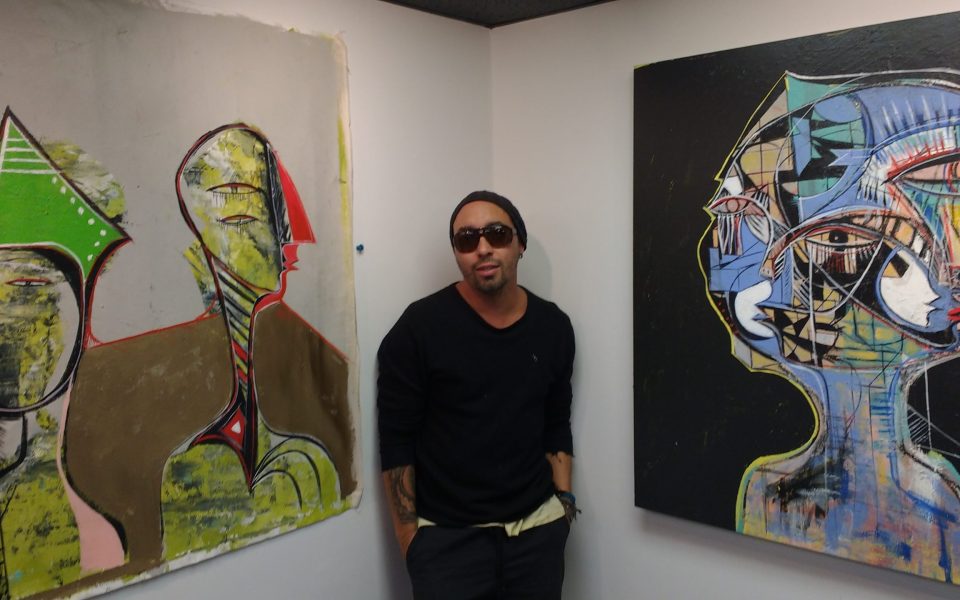If Nico Amortegui doesn’t like one of his paintings, he will pour gasoline on it and light it on fire.
Or walk all over it. Or throw it against the wall. Or perform any number of other violent measures against it.
But it’s all part of the process. When the piece is done, he said, it’s done.
On a bustling First Friday in downtown Greensboro, Amortegui’s art — or, more accurately, the ones strong enough to survive the very process of their creation — had made it to the upstairs gallery at Urban Grinders for his May show Color Me Bad. Nothing was on fire.
Amortegui goes by Malo, Spanish for “bad” or “villain,” which might be the perfectly mischievous title for someone who clearly enjoys challenging expectations.
“Art is my voice,” Amortegui said. “I’m able to speak to each person that my work comes in contact with, and most of my themes are of the hard realities of this world.”
The wealth of memories and emotions Amortegui said he draws from to conceive of his vibrant, architectural pieces — at times both joyful and jarring — are rooted in his childhood growing up among a highly artistic family and community in Bogota, Colombia.
“Everyone in my family has a connection with art,” he said.
“My grandfather is a carpenter, my dad an architect, my uncle is a painter, and my mother introduced me to art and design from childhood.”
It was also a neighborhood affair.
“I grew up in a small [neighborhood] where almost everyone was an artist,” he said. “Your brain collects things from your life, and that plays a role in who you become. Being surrounded by art eventually makes you want to become a creator instead of a spectator.”
When he moved to the United States when he was 17, Amortegui said he didn’t know who he was or what he was going to do. Being a full-time artist wasn’t feasible. He tried photography, but eventually fell in love with painting. Amortegui‘s experience selling pottery on the streets in Bogota with family members came in handy as he continued to paint.
“It taught me how to hustle,” he said.
Even though he’s shown paintings and sculptures in cities such as Miami, Los Angeles and Washington DC, Amortegui calls Charlotte home, saying that it’s better for him to be in North Carolina as opposed to a bigger city more known for its arts scene partially because the scene is less crowded here.
The show at Urban Grinders, which will run until the end of May, is of the caliber and style found in Miami galleries, combining a structural or quilted layout style with three-dimensional texture and unexpected color pairings, many emulating the aesthetic he picked up from his architectural and textile-pattern family background.
In one painting, a golden halo, earthy color scheme and baleful female figure staring out from the canvas is hauntingly reminiscent of Byzantine-era Madonna icons.
In a very different portraiture vein, the vibrant and stirring “Portrait of a Man II” brings to mind Mexican fresco painter David Alfaro Siqueiros’s “Jesus,” which resided this spring at the Weatherspoon Art Museum.
Amortegui’s inspirations include Jackson Pollock, George Condo, Jean Dubuffet, and Joan Miró, along with African-American folk art and Afro-Latino art. Lately he’s been inspired by Eugene Delacroix and Bible-inspired drawings by Japanese artist Sadao Watanabe.
Amortegui said he looks up to artists like Pollock because of his technique, energy and movement. Emulating his energy, he described much of his process as “slapping” paint onto his canvases.
“My process is extremely violent,” he said. “It’s all energy, and it goes from love to anger. I have to have a connection with the piece for her to allow me to create, but most of the time it’s fast and loud.”
The way Amortegui allows his art to organically take shape during this in-the-moment, responsive, energetic process can best be described as surrender.
“I paint like a child,” he said. “No thoughts, just keep slapping paint onto the canvas. If something’s not there, it won’t allow me to create it. I have no power over what I create.”
At the bar at Urban Grinders, as Wolf Temper’s unsettling house beats thudded in the echoing space, Amortegui scrolled through his Facebook photos to show a dramatic evolution in process and color in a previous painting.
“It had to be this way,” he said.
“I believe my life is predestined. Death is inevitable. I never had control; it’s easier to just let things be.”
Join the First Amendment Society, a membership that goes directly to funding TCB‘s newsroom.
We believe that reporting can save the world.
The TCB First Amendment Society recognizes the vital role of a free, unfettered press with a bundling of local experiences designed to build community, and unique engagements with our newsroom that will help you understand, and shape, local journalism’s critical role in uplifting the people in our cities.
All revenue goes directly into the newsroom as reporters’ salaries and freelance commissions.


Leave a Reply